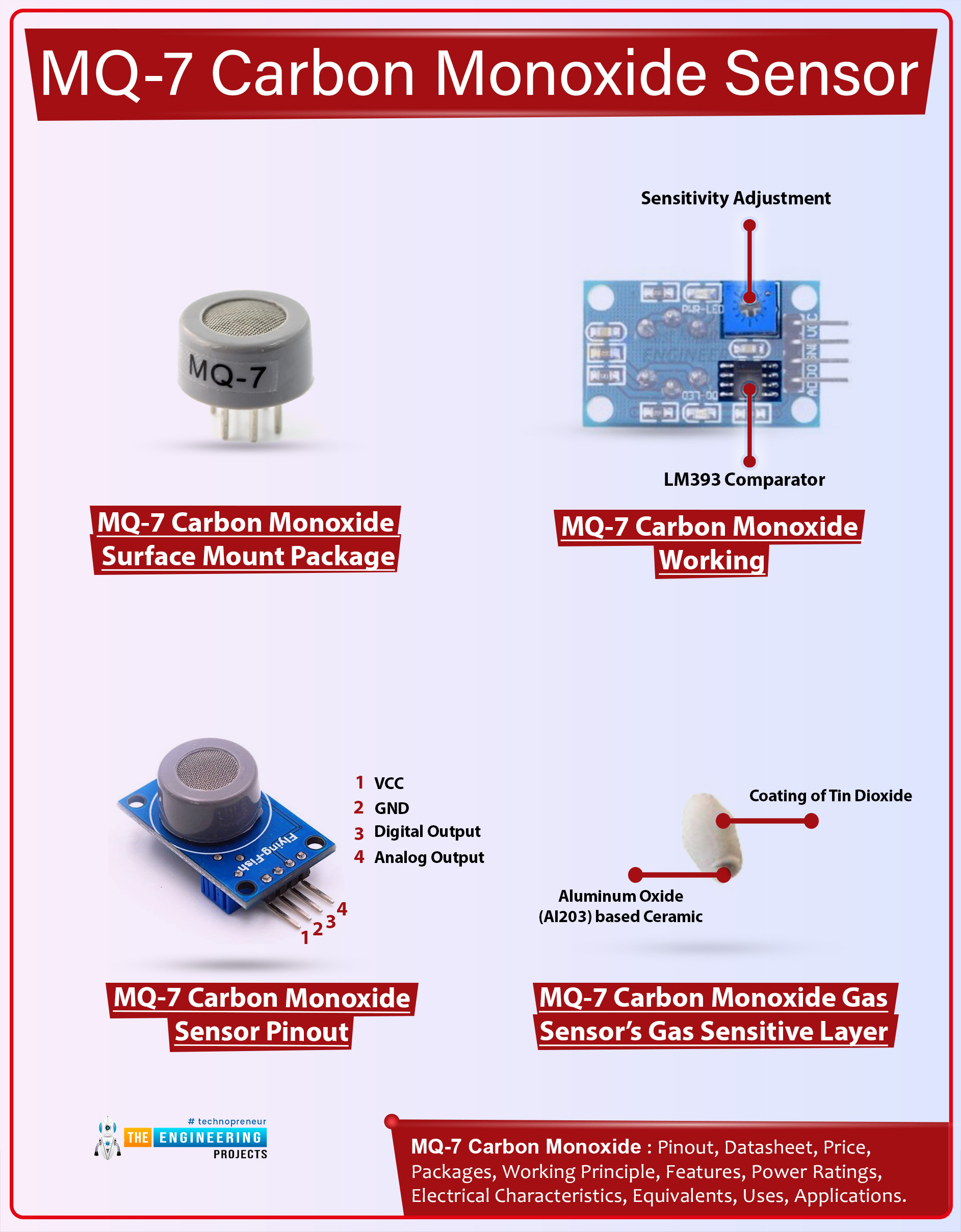
Hello peeps! I hope you are having a good day. We all know carbon monoxide is a dangerous and harmful gas that can even be fatal. It is a colorless and odorless gas so it is difficult to sense its presence therefore, different types of sensors and indicators are required to make the places safe especially those where there is a chance for carbon monoxide gas production as a byproduct. Here, one of the most promising detectors is the MQ-7 carbon monoxide sensor which instantly detects and indicates the presence so the users may save their lives. This is the most popular choice for this purpose because of its low cost, high performance, and instant response.
This article will commence by introducing the MQ-7 carbon monoxide sensor. Subsequently, we will delve into essential details from its datasheet, exploring its structure, pinout configuration, and performance-related graphs. Additionally, we will examine alternatives and package details, providing a comprehensive understanding. A detailed exploration of the working principle will follow. Towards the conclusion, notable examples highlighting the significant role of this sensor will be discussed. Let's embark on the exploration of the initial topic:
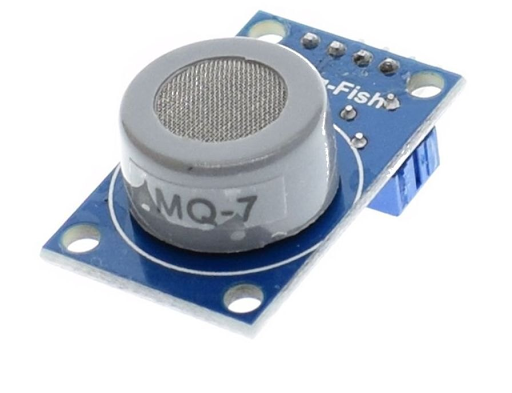
MQ-7 Carbon Monoxide Gas Sensor Introduction
The sensitive material of the MQ-7 carbon monoxide gas sensor is tin dioxide (SnO2). This is a reactive material to carbon monoxide and the basic working of this sensor depends on the heating process of this sensing element. Carbon monoxide (CO) is not usually present in fresh air therefore, the sensor does not provide any signal until it senses any leakage or danger.
This sensor consists of the following parts:
MQ-7 Carbon Monoxide Gas Sensor’s Gas Sensitive Layer
Just like other MQ sensors, this one also has a sensitive element made of ceramic that has a layer outside it. This layer consists of tin dioxide (SnO2) and has the feature of absorbing the target gas. In the case of MQ7, the tin dioxide absorbs the carbon monoxide and indicates its presence as soon as it comes in contact.
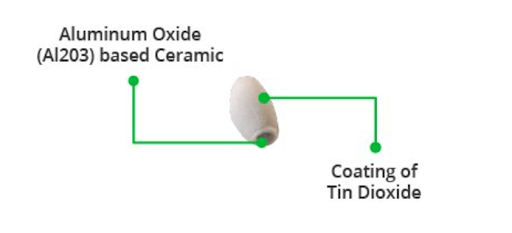
MQ-7 Carbon Monoxide Gas Sensor’s Gas Electrodes
The MQ-7 has electrodes that facilitate electrical contact with the sensitive material. Usually, it is made with the gold for the best performance. These allow the measurement of the electrical resistance.
MQ-7 Carbon Monoxide Gas Sensor’s Heater Coil
There is a coil in the heart of this sensor. This is made of alloy like Ni-Cr and provides heat to the sensitive layer to enhance its reaction and sensitivity.
MQ-7 Carbon Monoxide Gas Sensor’s Tubular Ceramics
The censor has a tubular structure of ceramic material such as alumina (Al2O3) and it provides support and strength to other components so that they may be at their place.
MQ-7 Carbon Monoxide Gas Sensor’s Anti-explosion Network
There is a network of double stainless steel mesh that performs two functions:
- It allows the gases to pass through it and retains the presence of any unwanted particles outside the network.
- It protects the internal structure because that is very reactive and delicate therefore, with the help of this network, all the internal structure remains in its place.
MQ-7 Carbon Monoxide Gas Sensor’s Resin Base
To create the whole system of the gas sensor, there is a firm base made with bakelite or other materials that provide the strength and the pin structure that ensure the working of the whole sensor.

Moreover, there are tube pins and clamp rings that provide extra strength to the circuit of the MQ-7 monoxide gas sensor.
MQ-7 Carbon Monoxide Sensor Datasheet
Before using any electrical component, it is important to understand the technical specifications. Here are some points to know before using the MQ-7 carbon monoxide sensor:
MQ-7 Carbon Monoxide Sensor Features
This sensor has an analog pin that shows the presence of carbon monoxide through the analog values
The digital pin is responsible for showing the presence or absence of the gas through a single value.
It has a simple structure therefore, it is a less power-consuming component.
It has a long life and is considered ideal to use in circuit-like IoT projects.
It is continuously in power so whenever it senses carbon monoxide in its surroundings, it shows a rapid response.
The typical detection range of this sensor is 10 ppm to 1000 ppm but it may vary depending on the model.
MQ-7 Carbon Monoxide Sensor Specification
Feature |
Specification |
Remarks |
Target Gas |
Primarily CO, with some cross-sensitivity to other combustibles |
N/A |
Detection Range |
10 ppm - 1000 ppm (CO) |
May vary depending on model and operating conditions |
Sensitivity |
High for CO, resistance decreases with increasing CO concentration |
|
Response Time |
30 seconds - 1 minute |
To reach 90% of final value |
Recovery Time |
3-5 minutes |
After gas exposure |
Operating Voltage |
5V DC |
N/A |
Operating Temperature |
-20°C to 50°C (typical) |
May vary depending on model |
Operating Humidity |
< 95% RH |
N/A |
Power Consumption |
~350 mW |
N/A |
Output Signal |
Analog (voltage) and Digital (trigger) |
Analog proportional to CO concentration |
Heater Resistance |
33Ω ± 5% |
N/A |
Sensing Resistance |
10KΩ - 60KΩ (1000 ppm CO) |
Standard detecting conditions |
Life Expectancy |
Several years |
Under proper usage |
Dimensions |
Varies by model (e.g., 32mm x 20mm x 22mm) |
N/A |
Weight |
~7 grams |
N/A |
MQ-7 Carbon Monoxide Sensor Pinout Configuration
Just like structure and other features, the pinout configuration of the MQ-7 carbon monoxide sensor has four pins and a simple structure. Here is the table that shows the pin number, names, and a brief description:
Pin Number |
Pin Name |
Description |
1 |
Vcc |
This is the power pin that requires 5V |
2 |
Ground |
This pin is used to connect the module to the system’s common ground |
3 |
Digital Out |
It is a digital output pin that shows the presence or absence of the CO gas. The threshold value for this pin can be set by using the potentiometer |
4 |
Analog Out |
It is the analogue output pin. It provides the analogue voltage based on the concentration of the gas |
The details of each pin will be clear when we study the working of this sensor in the communing section.
MQ-7 Carbon Monoxide Sensor Packages
For the convenience of the users, the MQ-7 carbon monoxide is available in different packages. Here is the detail of the most common packages:
MQ-7 Carbon Monoxide Sensor Through-Hole Package (DIP)
This is the most common package that usually has four pins for connection to a PCB through the soldering process.
It's readily available for use and the advantage is, that it has easy integration into existing circuits.
The negative point is, that it requires manual soldering and has a larger footprint compared to other packages.
MQ-7 Carbon Monoxide Sensor Surface Mount Package (SMD)
This package is relatively smaller and is designed for surface mounting on PCBs.
It offers easier integration into printed circuit boards and therefore is used by beginners as well.
The negative point is, that it requires specialised soldering equipment that is not always available for all the users and may be more sensitive to environmental factors.
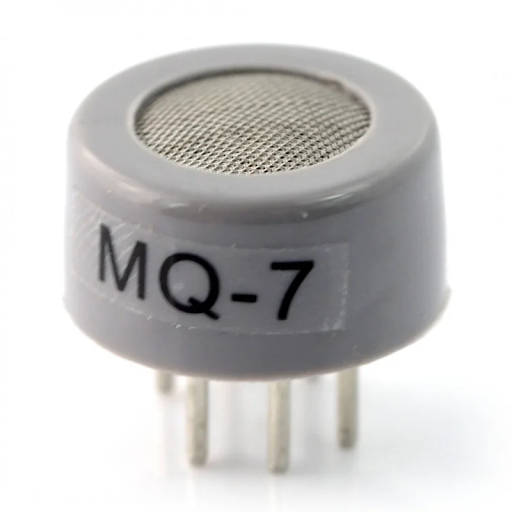
MQ-7 Carbon Monoxide Sensor Module Package
It includes the sensor itself along with additional components for better working such as the voltage regulators and filtering capacitors.
It's easier to use as compared to the other options in the list and provides plug-and-play functionality.
The negative point is, that it has a larger footprint and can be more expensive compared to basic packages.
MQ-7 Carbon Monoxide Sensor Alternatives
Some other fellows of the MQ family also can detect carbon monoxide to some extent but it is advisable to use the most sensitive and particular devices to detect such types of toxic gases. Here are noteworthy alternatives that can substitute for the MQ-7 carbon monoxide gas sensor:
MQ-9 is another sensor from the MQ series and it can detect multiple gases including carbon monoxide and methane.
MiCS-5524 is the sensor that can detect gases like Carbon Monoxide, Methane, and LPG Gas Sensor. It's a small sensor and is used in multiple projects in different domains.
An important alternative for this sensor is the Figaro TGS Series that have multiple gas sensors for gas detection.
The SGX Sensortech MICS-5524 is another sensor that can detect carbon monoxide, methane, and LPG gas and shows high sensitivity towards multiple gases.
Where to Buy MQ-7 Carbon Monoxide Sensor
Buying the electrical component is a big responsibility because every member of the circuit affects the overall accuracy. You must buy sensors like MQ-7 without facing technical issues:
eBay
AliExpress
Amazon
MQ-7 Carbon Monoxide Sensor Working Principle
The basic working principle of this sensor is similar to the other MQ series compoeents. In the heart of this sensor, the tin oxide (SnO2) is present in a tubular shape. The circuit of this sensor is designed in such a way that as soon as the circuit is powered on, the tin oxide is heated to stimulate its absorption process at a high rate.
Once the tin oxide is stimulated, it absorbs the oxygen from its surroundings and the ions are created at a high rate. As a result, a depletion region forms around the sensing element that enhances the electrical resistance.
Now, the electric current passing through the sensor is very small and this indicates that there is no toxic carbon monoxide present in the surroundings.
As soon as there is an amount of CO in the air and it reaches the sensor, the depletion region starts reacting with it and as a result, the smaller number of ions contributes to less resistance.
In the end, the low resistance results in the high electrical conductance that is indicated in the sensor.
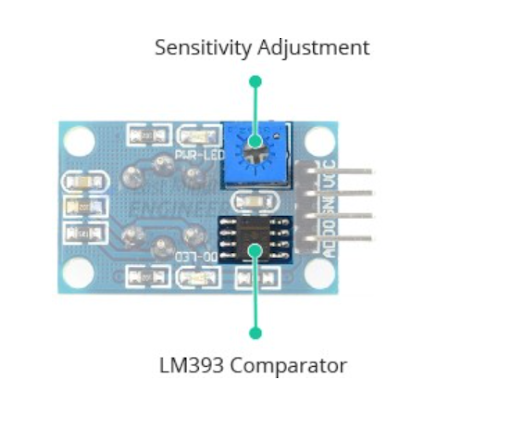
The output on the analog pin is directly proportional to the amount of carbon monoxide present in the air.
MQ-7 has a potentiometer in it through which the threshold values are set. Once the analogue values reach the threshold value, the sensor shows the signal through the digital pin. A comparator is used in the module that is responsible for comparing the values on these pins.
These pins are connected to the output devices which may be any buzzer, screen, or anything else based on the project.
MQ-7 Carbon Monoxide Sensor Physical Dimensions
Before using MQ-7 in the circuit, the physical dimensions will help you to understand its size and other specifications. This table will show the details of each parameter with the unit:
Dimension |
Value (mm) |
Range (mm) |
Length |
33 |
32 - 35 |
Width |
21 |
20 - 22 |
Height |
13 |
11 - 15 |
Weight |
7 |
N/A |
Shape |
Rectangular with rounded corners |
N/A |
Pin configuration |
4 or 5 (model dependent) |
N/A |
Mounting holes |
2 (sides) |
N/A |
MQ-7 Carbon Monoxide Sensor Applications
Carbon monoxide is used in different industries in such places, so using the sensing system is a must. Here are some general examples where the MQ-7 carbon monoxide can be integrated for the detection:
Air quality monitoring
Industrial safety
Home and office safety systems
Environmental monitoring
Combustible gas detection
Automotive emissions monitoring
Gas leak detection systems
Portable gas detectors
Agricultural and greenhouse applications
HVAC systems
Hence, today we have read the details of a life-saving sensor that is MQ-7 carbon monoxide sensor. It is used in multiple projects and we started learning through its introductions and details of its internal components. After that, we saw the datasheet elements like its specifications, features, and some important information about its structure. just after that, we read about its working principle, physical dimensions and some important applications where this sensor can be used. I hope all the points are clear to you but if you want in-depth information then you can ask in the comment section.



